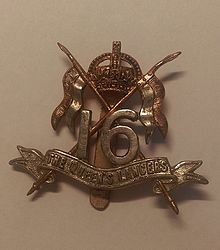16th Lancers
| 16th The Queen's Lancers | |
|---|---|

Badge of 16th The Queen's Lancers
|
|
| Active | 1759–1922 |
| Country |
|
| Branch |
|
| Type | Line Cavalry |
| Size | Regiment |
| Nickname(s) | "The Scarlet Lancers" |
| Motto(s) |
Aut cursu, aut cominus armis (Either in the charge or in hand-to-hand combat) |
| March | Quick: The English Patrol Slow: The 16th Lancers |
| Anniversaries | Aliwal (28 January) |
| Commanders | |
| Notable commanders |
General John Burgoyne |
General John Burgoyne
Field Marshal William Harcourt, 3rd Earl Harcourt
The 16th The Queen's Lancers was a cavalry regiment of the British Army, first raised in 1759. It saw service for two centuries, before being amalgamated with the 5th Royal Irish Lancers to form the 16th/5th Lancers) in 1922.
The regiment was raised in 1759 by Colonel John Burgoyne as the 16th Regiment of (Light) Dragoons, being the second of the new regiments of light dragoons; it was also known as Burgoyne's Light Horse. The regiment was closely involved, undertaking several cavalry charges, in the action leading up to the capture of the French Garrison of Belle Île in April 1761 during the Seven Years' War. It also made a major contribution to the British victories against the Spaniards at the Battle of Valencia de Alcántara in August 1762 and at the Battle of Vila Velha in October 1762 during the Anglo-Spanish War. In 1766 the regiment was renamed after Queen Charlotte as the 2nd (or The Queen's) Regiment of (Light) Dragoons, the number being an attempt to create a new numbering system for the light dragoon regiments. However, the old system was quickly re-established, with the regiment returning as the 16th (The Queen's) Regiment of (Light) Dragoons in 1769. The regiment arrived in New York in October 1776 for service in the American Revolutionary War. It was involved in fighting at the Battle of White Plains in October 1776, the Battle of Brandywine in September 1777 and the Battle of Germantown in October 1777 before seeing more action at the Battle of Crooked Billet in May 1778, the Battle of Barren Hill later that month and the Battle of Monmouth in June 1778. The regiment returned to England in spring 1779. The regiment next landed at Ostend in April 1793 for service in the Flanders Campaign and was present at the Siege of Valenciennes in June 1793, the Siege of Dunkirk in August 1793 and the Siege of Landrecies in April 1794. It also took part in the Battle of Beaumont in April 1794, the Battle of Willems in May 1794 and the Battle of Tournay in later that month before returning to England in February 1796. The regiment was then based in Ireland between autumn 1802 and 1805.
...
Wikipedia
